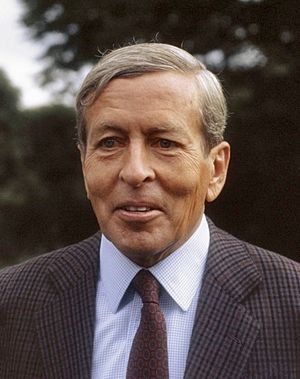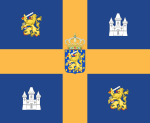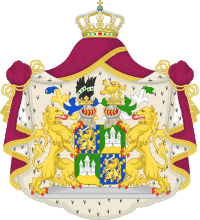Prince Claus of the Netherlands facts for kids
Quick facts for kids Claus von Amsberg |
|
|---|---|

Prince Claus in 1986
|
|
| Prince consort of the Netherlands | |
| Tenure | 30 April 1980 – 6 October 2002 |
| Born | Klaus-Georg Wilhelm Otto Friedrich Gerd von Amsberg 6 September 1926 Hitzacker, Germany |
| Died | 6 October 2002 (aged 76) Bijlmermeer, Netherlands |
| Burial | 15 October 2002 Nieuwe Kerk, Delft, Netherlands |
| Spouse | |
| Issue | Willem-Alexander of the Netherlands Prince Friso Prince Constantijn |
| House | Amsberg |
| Father | Claus Felix von Amsberg |
| Mother | Baroness Gösta von dem Bussche-Haddenhausen |
| Religion | Lutheranism (until 1966) Reformed (from 1966) |
| Occupation | |
| Signature |  |
Prince Claus of the Netherlands, Jonkheer van Amsberg (born Klaus-Georg Wilhelm Otto Friedrich Gerd von Amsberg; 6 September 1926 – 6 October 2002) was Prince consort of the Netherlands from 30 April 1980 until his death in 2002 as the husband of Queen Beatrix.
Contents
Biography
Klaus-Georg Wilhelm Otto Friedrich Gerd von Amsberg was born on his family's estate, Castle Dötzingen, Hitzacker, Germany, on 6 September 1926. He was the second child and only son of Claus Felix von Amsberg and his wife, Baroness Gösta von dem Bussche-Haddenhausen. His father, by birth a member of House of Amsberg which belonged to the untitled German nobility from Mecklenburg, operated a large farm in Tanganyika (formerly German East Africa) from 1928 until World War II. His mother belonged to the ancient von dem Bussche noble family which originated from the County of Ravensberg. From 1938, Claus and his six sisters grew up on their maternal grandparents' estate in Lower Saxony; he attended the Friderico-Francisceum-Gymnasium in Bad Doberan from 1933 to 1936 and a boarding school in Tanganyika from 1936 to 1938.
Claus was a member of such Nazi youth organisations as Deutsches Jungvolk and the Hitler Youth . From 1938 until 1942, he attended the Baltenschule Misdroy.
In 1944, Claus was conscripted into the German Wehrmacht, becoming a soldier in the German 90th Panzergrenadier Division in Italy in March 1945. He was taken prisoner of war by the American forces at Meran before taking part in any fighting. After his repatriation, he finished school in Lüneburg and studied law in Hamburg. He then joined the German diplomatic corps and worked in Santo Domingo and Ivory Coast. In the 1960s, he was transferred to Bonn.
Claus met Princess Beatrix for the first time on New Year's Eve 1962 in Bad Driburg at a dinner hosted by the Count von Oeynhausen-Sierstorpff, who was a distant relative of both of them. Claus and Beatrix were also distantly related (5th cousins twice removed), as both being descendants from von dem Bussche family. They met again at the wedding-eve party of Princess Tatjana of Sayn-Wittgenstein-Berleburg and Moritz, Landgrave of Hesse, in the summer of 1964. With memories of German oppression still very strong 20 years after the war, sections of the Dutch population were unhappy that Beatrix's fiancé was a German and former member of the Hitler Youth. Nonetheless, Queen Juliana gave the engagement her blessing after giving serious thought to canceling it. The engagement was approved by the States-General—a necessary step for Beatrix to remain in the line of succession to the throne—in 1965. He was granted Dutch citizenship later that year and changed the spellings of his names to Dutch.
The couple were married on 10 March 1966. Their wedding day saw violent protests, most notably by the anarchist-artist group Provo. They included such memorable slogans as "Claus, 'raus!" (Claus, get out!) and "Mijn fiets terug" (Give me back my bike), a reference to the memory of occupying German soldiers confiscating Dutch bicycles. A smoke bomb was thrown at the wedding carriage by a group of Provos. For a time, it was thought that Beatrix would be the last monarch of the Netherlands.
However, over time, Claus became accepted by the public, so much so that during the last part of his life he was considered by some to be the most popular member of the Royal Family. This change in Dutch opinion was brought about by Claus's strong motivation to contribute to public causes (especially Third World development, on which he was considered an expert), his sincere modesty and his candor (within but sometimes on the edge of royal protocol).
The public also sympathised with Claus for his efforts to give meaning to his life beyond the restrictions that Dutch law imposed on the Royal Family's freedom of speech and action. However, these restrictions were gradually loosened; Claus was even appointed as senior staff member at the Department of Developing Aid, albeit in an advisory role.
One example of his attitude toward protocol was the "Declaration of the Tie". In 1998, after presenting the annual Prince Claus Awards to three African fashion designers, Claus told "workers of all nations to unite and cast away the new shackles they have voluntarily cast upon themselves", meaning the necktie, that "snake around my neck," and encouraged the audience to "venture into open-collar paradise". He then removed his tie and threw it on the floor.
Claus battled depression for a number of years, and underwent surgery in 1998 to remove his prostate. In 2001, he underwent another surgery to remove one of his kidneys. He eventually died on 6 October 2002 from Parkinson's disease and heart failure.
Activities
As a husband of the heir, Claus was a member of the National Advisory Council for Development Cooperation and its Bureau, and was a chair of the National Committee for Development Strategy 1970‑1980 and the Netherlands Development Organization. He also worked as special advisor to the Minister for Development Cooperation. He held these positions until 1980.
On 30 April 1980, Claus' mother-in-law, Queen Juliana, abdicated in favour of Princess Beatrix, who became Queen of the Netherlands. After the investiture, the couple visited the Netherlands Antilles and Aruba. As a prince consort, Prince Claus frequently visited public organisations, commercial and industrial enterprises, and companies in the agriculture and fisheries sector.
In 1984, Claus became the Inspector General for Development Cooperation, member of the Board of Directors of De Nederlandsche Bank N.V. (until 1998), member of the Board of Directors of Royal PTT Nederland, and Chair of the Transport and Public Works Platform.
Claus was an honorary chair of the National Coordinating Committee for the Protection of Monuments and Historic Buildings and the King William I Foundation. He was also a patron of the Concertgebouw Orchestra and Scouting Netherlands.
On Claus' seventieth birthday, the Prince Claus Fund for Culture and Development was established on the initiative of the Dutch government. The fund focused on enhancing understanding of cultures and promoting interaction between culture and development.
Declining health and death
Claus suffered various health problems, such as depression, cancer and Parkinson's disease. He died of complications of pneumonia and Parkinson's at the Academic Medical Center in Amsterdam on 6 October 2002 after a long illness, aged 76. He died less than four months after the birth of his first grandchild.
Claus was interred in the Royal Family's tomb in Delft on 15 October. It was the first full state funeral since Queen Wilhelmina's in 1962.
Titles, styles, honours, and arms
Titles
- 6 September 1926 – 16 February 1966: Klaus von Amsberg
- 16 February 1966 – 10 March 1966: Claus van Amsberg
- 10 March 1966 – 6 October 2002: His Royal Highness Prince Claus of the Netherlands, Jonkheer van Amsberg
Honours
National
Foreign
 Austria:
Austria:
 Grand Star of the Decoration of Honour for Services to the Republic of Austria (1994)
Grand Star of the Decoration of Honour for Services to the Republic of Austria (1994)
 Denmark:
Denmark:
 Knight of the Order of the Elephant (29 October 1975)
Knight of the Order of the Elephant (29 October 1975)
 Ethiopian Imperial Family:
Ethiopian Imperial Family:
 France:
France:
 Grand Cross of the Order of the Legion of Honour (1984)
Grand Cross of the Order of the Legion of Honour (1984)
 Germany:
Germany:
 Grand Cross Special Class of the Order of Merit of the Federal Republic of Germany (1 March 1983)
Grand Cross Special Class of the Order of Merit of the Federal Republic of Germany (1 March 1983)
 Iceland:
Iceland:
 Italy:
Italy:
 Knight Grand Cross with Collar of the Order of Merit of the Italian Republic (27 March 1985)
Knight Grand Cross with Collar of the Order of Merit of the Italian Republic (27 March 1985)
 Ivory Coast:
Ivory Coast:
 Japan:
Japan:
 Norway:
Norway:
 Portugal:
Portugal:
 Grand Cross of the Military Order of Christ (14 May 1991)
Grand Cross of the Military Order of Christ (14 May 1991)
 South Africa:
South Africa:
 Spain:
Spain:
 Knight Grand Cross of the Order of Charles III (7 October 1985)
Knight Grand Cross of the Order of Charles III (7 October 1985) Knight Grand Cross of the Order of Isabella the Catholic
Knight Grand Cross of the Order of Isabella the Catholic
 Sweden:
Sweden:
 Tunisia:
Tunisia:
 United Kingdom:
United Kingdom:
 Honorary Knight Grand Cross of the Royal Victorian Order (18 November 1982)
Honorary Knight Grand Cross of the Royal Victorian Order (18 November 1982)
Academic awards
- Honorary Doctor of the International Institute of Social Studies (1988)
Prince Claus was also appointed Honorary Fellow of the International Institute of Social Studies (ISS) in 1988. Prince Claus was held in very high esteem in the international development cooperation community, partly because of his considerable insight and understanding of the problems involved, and partly because of his exceptional gift for expressing the hopes and anxieties felt by all.
Issue
| Name | Birth | Death | Marriage | Children | |
|---|---|---|---|---|---|
| Date | Spouse | ||||
| King Willem-Alexander | 27 April 1967 | 2 February 2002 | Máxima Zorreguieta Cerruti | Catharina-Amalia, Princess of Orange Princess Alexia Princess Ariane |
|
| Prince Friso | 25 September 1968 | 12 August 2013 | 24 April 2004 | Mabel Wisse Smit | Countess Luana Countess Zaria |
| Prince Constantijn | 11 October 1969 | 17 May 2001 | Laurentien Brinkhorst | Countess Eloise of Orange-Nassau Count Claus-Casimir of Orange-Nassau Countess Leonore of Orange-Nassau |
|
See also
 In Spanish: Nicolás de Amsberg para niños
In Spanish: Nicolás de Amsberg para niños





